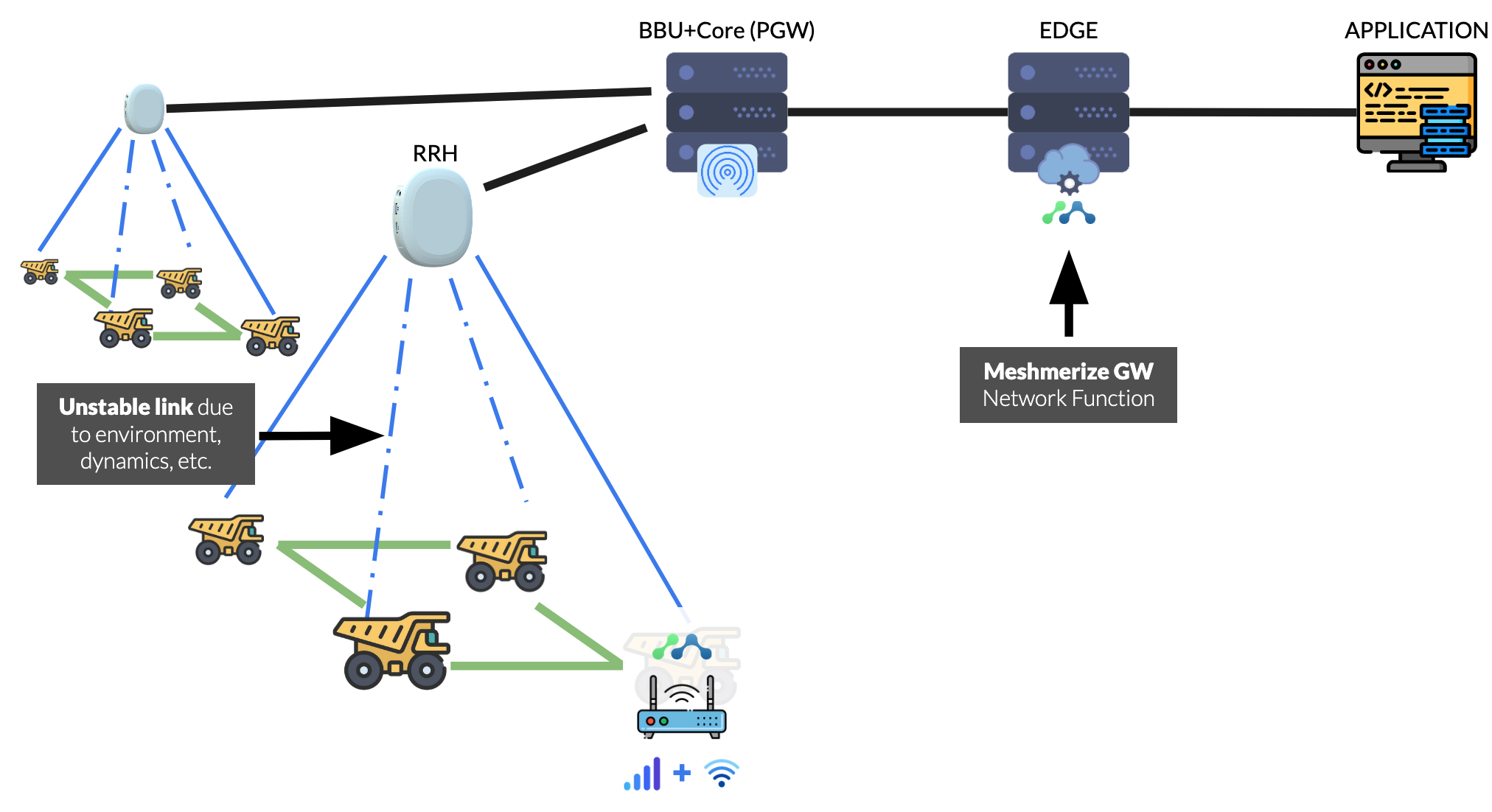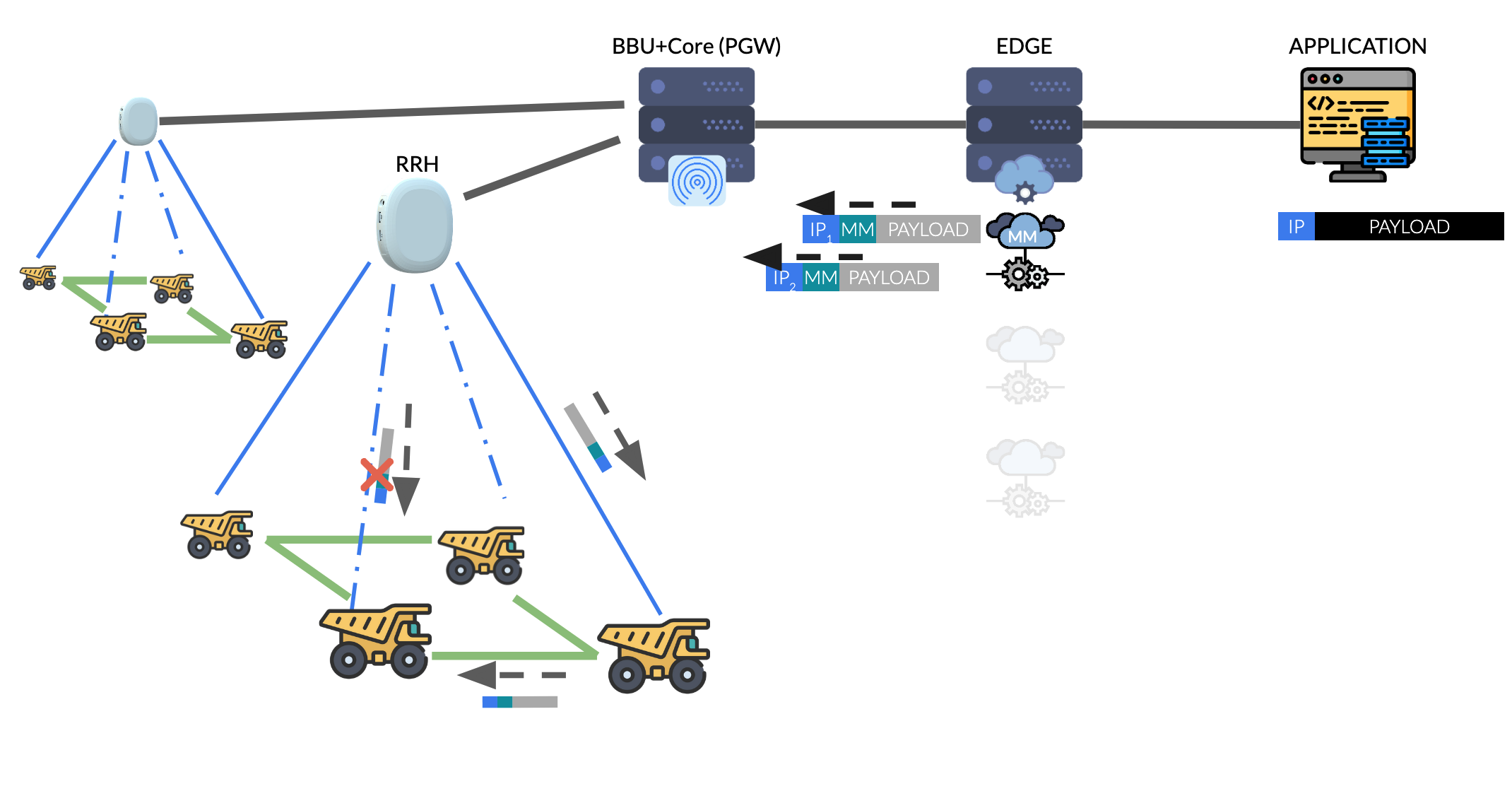¶ A Technical Overview of Hybrid Mesh Networking - LTE/5G with Meshmerize
¶ 1. Introduction: Beyond the Limits of a Single Network
At its core, Meshmerize creates intelligent, self-healing wireless networks by routing data over multiple Wi-Fi paths simultaneously. This multi-path approach delivers unparalleled resilience and reliability for critical operations. Today, we are extending this intelligence beyond Wi-Fi by integrating cellular (LTE/5G) connectivity directly into the mesh fabric. This document provides a technical overview of how Meshmerize leverages cellular links not merely as a backup, but as a fully integrated part of the network. The result is a hybrid mesh that intelligently combines the strengths of local Wi-Fi meshing with the wide-area coverage of cellular, creating a single, seamless, and exceptionally robust network for the most demanding environments.
¶ 2. How It Adds Value: Key Use Cases
By treating LTE/5G as another path in its routing calculus, Meshmerize unlocks powerful new deployment models.
¶ Use Case 1: Enhanced Reliability & Coverage Extension

Imagine a mining operation or a large agricultural site where cellular coverage is good overall but inconsistent in specific locations, such as deep within a mine or in a rolling valley. In a Meshmerize deployment, every node can be equipped with both Wi-Fi and LTE modems.
- Standard Operation: Nodes communicate over LTE for wide-area connectivity.
- The Meshmerize Advantage: When a node moves into a cellular "not-spot," it doesn't go offline. Instead, Meshmerize instantly and automatically detects the degraded LTE link and reroutes its traffic through a Wi-Fi mesh connection to a nearby node that has a stable cellular signal. The mesh transparently fills the gaps in cellular coverage, ensuring 100% network uptime.
¶ Use Case 2: Cost-Effective & Flexible Deployments
Equipping every single device with a cellular modem and data plan can be cost-prohibitive. Meshmerize enables a more economical "gateway" model.
- The Architecture: A few strategic nodes are deployed with LTE/5G modems, acting as cellular gateways. These are surrounded by numerous cheaper, Wi-Fi-only nodes.
- The Meshmerize Advantage: The Wi-Fi-only nodes form a mesh network and seamlessly route their traffic to the nearest LTE-enabled gateway node. This allows you to share a single cellular backhaul connection across dozens of devices o, drastically reducing hardware and operational costs without sacrificing connectivity for the wider group.
¶ 3. The Meshmerize Magic: How It Works Under the Hood
The power of this feature lies in how Meshmerize abstracts the complexity of the underlying networks. From an application's perspective, it's just talking to an IP address; Meshmerize handles the "how" and "where" of packet delivery.

¶ The Architecture: The Meshmerize Gateway
To integrate cellular networks, the system utilizes a component called the Meshmerize Gateway. This is a lightweight instance of the Meshmerize software that offers complete deployment flexibility. While it often runs in a public or private cloud environment, it can also be hosted entirely on-premises. This capability is critical for fully air-gapped deployments or remote sites, such as mines, where all infrastructure must remain on-site and a connection to the public internet is neither available nor desired. Its role is strictly to act as a secure gateway for traffic that needs to enter or exit the local mesh network. It is important to note that the Meshmerize Gateway is not a central network controller. Communication between nodes inside the mesh (node-to-node) is direct and does not flow through the gateway. If a group of nodes is disconnected from the gateway (e.g., no LTE signal is available anywhere), they continue to function perfectly as a self-contained local mesh.
¶ Creating the Hybrid Fabric: Link Abstraction & Measurement
Meshmerize’s routing engine sees every possible connection as a "link" with an associated quality score.
- Wi-Fi Links: The quality of local mesh links is measured by sending periodic beacons and calculating a performance metric based on packet loss and signal strength. This is ideal for the volatile nature of Wi-Fi.
- LTE Links: An LTE connection is abstracted as a persistent link to the Meshmerize Gateway. Because cellular is an L3 network, Meshmerize encapsulates its L2 Ethernet frames into UDP packets to traverse it. Your assumption is correct: since underlying cellular protocols already handle error correction and retransmissions, raw packet loss is a poor indicator of link quality. Therefore, Meshmerize measures the quality of the LTE link primarily based on its latency, providing a much more accurate view of real-time performance.

¶ Security by Design: Secure Tunnels
Sending operational data over an LTE network demands robust security. All UDP traffic traveling between a Meshmerize node and the Meshmerize Gateway over the cellular network is encapsulated within a secure WireGuard® tunnel. This provides strong, state-of-the-art encryption, ensuring that all data is protected from eavesdropping and tampering.
¶ Intelligent Path Control & Traffic Prioritization
With a real-time understanding of the quality of every available path (Wi-Fi or LTE), the Meshmerize engine makes intelligent routing decisions on a packet-by-packet basis. Furthermore, users can configure traffic prioritization rules. This allows the system to treat different data flows according to their importance. For example:
- Bulky, non-critical traffic (e.g., WiFi internet access) can be routed over the single best-available link.
- Critical traffic (e.g., control commands, safety alerts, video for remote control) can be configured for maximum resilience. For this traffic, Meshmerize will perform packet duplication, sending the same packet simultaneously over multiple paths (e.g., both a Wi-Fi link and the LTE link). The core Meshmerize software handles the necessary deduplication and reordering at the receiving end, guaranteeing that the application receives the critical packet exactly once and in the correct order, with the lowest possible latency.
¶ 4. Frequently Asked Questions (FAQ)
-
Can a node use multiple LTE connections, for instance, from two different carriers?
Yes. A node can be equipped with multiple LTE modems. Meshmerize will treat each as a distinct link, measuring its performance independently and routing traffic based on your configured policies (e.g., for failover, load-balancing, or prioritizing a private LTE network over a public one).
-
Is my data secure when it travels over the LTE network?
Yes. All traffic between the node and the Meshmerize Gateway is encrypted end-to-end within a secure WireGuard tunnel.
-
What happens if all my nodes lose their connection to the Meshmerize Gateway?
Your local mesh network continues to operate without interruption. All nodes within the mesh can still communicate directly with each other. They only lose connectivity to external services (e.g., the internet or a cloud management platform) until a link to the gateway is re-established.
-
My deployment uses external LTE modems connected to my Meshmerize nodes via an Ethernet port. Is this configuration supported?
Yes, absolutely. The Ethernet port connected to the external modem can be configured to be treated as an "LTE link." Meshmerize will then apply its specific logic for cellular links—such as latency-based quality measurement and secure tunneling to the Gateway—to this interface, fully integrating it into the multi-path routing fabric.
-
Does the cellular link require special configuration from the network provider?
No. No special configuration is needed from the cellular provider. Meshmerize treats the LTE/5G connection as a standard IP link and sends its traffic over it via UDP. As long as the modem provides basic IP connectivity—whether on a public or a private network—it will work out of the box.
-
Do all nodes in my network need an LTE modem?
No. The system is designed to support mixed deployments, where only a few gateway nodes have LTE modems, sharing their connectivity with nearby Wi-Fi-only nodes. This significantly reduces total cost of ownership.
¶ 5. Conclusion
The Meshmerize LTE/5G integration transforms your network into a single, intelligent, hybrid fabric. By combining the local area resilience of Wi-Fi mesh with the wide-area coverage of cellular, it provides a networking solution that is more flexible, more reliable, and more cost-effective than any single-technology approach. The complexity of this hybrid operation is completely abstracted, delivering a robust and seamless connectivity platform for your most critical operations.